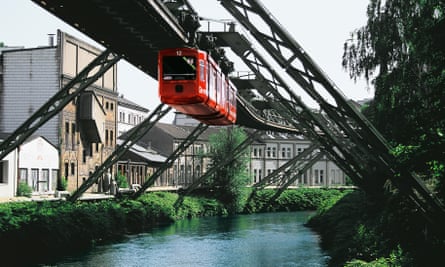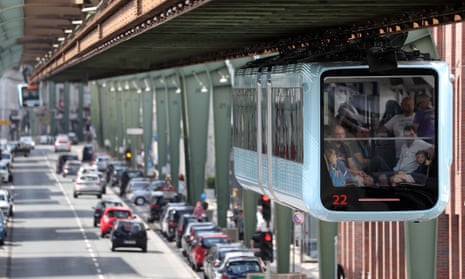The world’s oldest electric suspension railway has reopened in the western German city of Wuppertal after the longest closure in its history for extensive repairs.
Commuters and train buffs greeted the hanging train, or the Schwebebahn, which had been shut down for almost nine months, with cheers and applause as it left its depot in Oberbarmen just after dawn.
“Wuppertal is rather attached to its suspension train,” the city’s mayor, Andreas Mucke, told the assembled crowd. “She is not only the most important means of transport … but amounts to the city’s trademark, known across the world.”
The 120-year-old railway, which carries 85,000 passengers a day on its eight-mile route, was closed after the collapse of a part of the power distribution system in November.
A Wuppertal-born poet, Else Lasker-Schüler, has compared travelling on the monorail to an airy flight on the back of a “steely dragon”. The majority of the journey follows the path of the rapidly running Wupper River, 12 metres (39 ft) below the carriages. At the end of the line the track loops elegantly to allow for the trains to be turned around.

The railway’s operators say its advantages include not having to contend with traffic jams or junctions or indeed with snow or leaves on the track.
It attracts transport enthusiasts from around the world who can ride on its circuit on a 24-hour ticket for €7.10 (£6.50), and architecture fans are often drawn to its 20 striking stations ranging from the modern, glassy Kluse to the art nouveau-style Werther Bridge.
The recent closure was the railway’s longest since the second world war, during which it was bombed extensively. Officials then saw it as a point of pride to put all the necessary resources into restoring the city’s most important hallmark swiftly, and it was reopened in 1946.
The Schwebebahn has inspired poets and songmakers. It is referred to in Theodor Herzl’s 1902 utopian novel Altneuland (The Old New Land), in which it is cited as the ideal form of city transport. It features in the filmmaker Wim Wenders’ Alice in den Städten (Alice in the Cities) and in the Turner prize nominee Darren Almond’s 1995 Train Trilogy.

The most famous incident in its history concerns an Indian elephant. In July 1950 a three-year-old animal called Tuffi, who was in Wuppertal with Frank Althoff’s touring circus, was loaded into carriage number 13 along with a pack of journalists and fans as part of a publicity stunt.
According to witnesses, the elephant, panicked by the crush in the overcrowded car, sat on a wooden seat, causing it to break, before charging with all her might through the left side of the train.
She landed in the river 12 metres below. Her fall was broken by a muddy bank and left her with just a bruised behind, but the train carriage was demolished and several journalists were injured.
It happened so quickly that no photographs exist of the plunge, only of the elephant standing in the muddy water. But this has not stopped the city selling photo montages of the incident, alongside plenty of other Schwebebahn paraphernalia, from gummy bear trains and cookie cutters to T-shirts and chocolates.
Althof and the city’s head of the transport were eventually fined 450 marks and told by a judge that the only animals allowed on the suspension railway were guide and police dogs.
